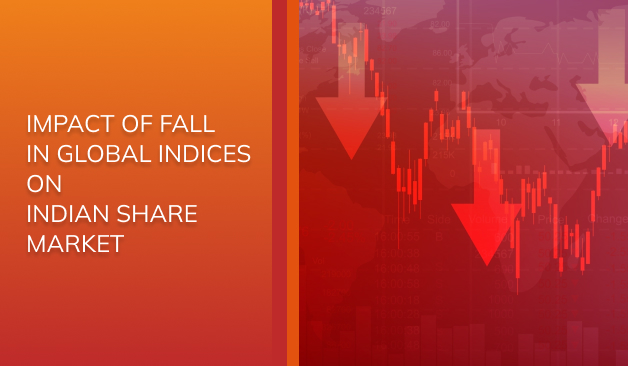
Impact of Fall in Global Indices on Indian Share Market
The Indian stock market opened deep in the red on Monday, 7th April 2025, as both the Nifty and Sensex opened with a gap-down and fell sharply by around 3.5% during the course of the day.
What happened on Dalal Street wasn’t an isolated event. Share market indices across the globe faced even greater shocks: Japan’s Nikkei 225 dropped nearly 8%, Hong Kong’s Hang Seng plunged over 13%, China’s CSI 300 fell more than 7%, and South Korea’s KOSPI declined by around 5.5%.
Why Did Global Markets Crash?
The primary trigger behind the global market sell-off was the announcement of unexpectedly increased reciprocal tariffs by the US President Donald Trump, followed by retaliatory measures from China. Adding fuel to the fire were growing fears of a potential recession in the US, which further deepened market concerns.
Historical Parallels: 2008 and 2018
We’ve seen global crashes before. In 2008, when Lehman Brothers—a major player in the US banking sector—collapsed, Indian benchmarks like the Nifty, Sensex, and Nifty 500 crashed nearly 60% from their yearly peaks. That drop was driven largely by foreign investors exiting emerging markets, including India.
Back in February 2018, the U.S. markets experienced a sharp correction when fears of rising inflation and interest rates spooked investors. The Dow Jones fell nearly 1,200 points in a single day. The impact? Within hours, Indian markets mirrored the panic. The Sensex plunged over 1,200 points, and the Nifty fell nearly 300 points. This episode served as a stark reminder of just how intertwined global financial markets had become.
The Ripple Effect on Indian Markets
In an interconnected world, global market disruptions inevitably impact India. Let’s break down the nature of this impact, whether it's short-term or more prolonged.
Market Volatility
With today’s globalised financial systems, market interconnectedness amplifies the ‘contagion effect,’ where a crisis in one region quickly spreads across borders. As a result, volatility in benchmark indices like Nifty and Sensex is likely to remain elevated until the situation stabilizes.
Investor Sentiment
Sharp declines in Indian markets could shake investor confidence, at least in the near term. This may result in a slowdown in fresh investments or even profit booking by existing investors (including FIIs) looking to shift their holdings to safer waters in times of heightened volatility.
Sectoral Impact
Certain sectors—particularly IT and Pharma—are bearing the brunt due to their significant exposure to global trade. These sectors could remain volatile in the short term. But to truly understand the impact, we need to extend our view over a longer horizon.
IT Sector
The Indian IT sector is likely to face headwinds due to potential client-level budget cuts in the US amid reciprocal tariffs. These tariffs are inflationary and could slow down economic growth, leading to reduced tech spending. Additionally, the rising cost of sourcing equipment may put large-scale transformation projects (an important revenue stream for Indian IT firms) on hold. As things stand, FY26 may witness muted growth, with a meaningful recovery likely only in FY27.
Pharma Sector
Indian pharma exports account for nearly 40% of generic drug volumes in the US. The imposition of tariffs on these exports could severely squeeze margins, making it difficult for companies to sustain profitability. While this has already triggered short-term volatility, a definitive long-term outlook is premature until tariff structures are confirmed and trade negotiations conclude.
Navigating the Uncertainty
While the global market jolt may shake investor’s confidence, it’s important to remember that such phases, though unsettling, are not unprecedented. Investors could see this as a time to reassess portfolios, focus on fundamentals, and avoid making emotional or impulsive moves. As always, staying updated, seeking professional guidance, and keeping a long-term perspective remain key to weathering volatility.










